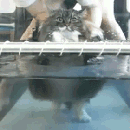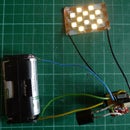Introduction: Belkin Tunecast II FM Transmitter Mod
Belkin is a popular manufacturer of cheap and cheerful computer accessories, having singlehandedly made the USB hub sexy! One of their more popular product hitching the iPod popularity ride, is the Tunecast II FM Transmitter.
It is only earlier this year (2007) that FM transmitters like these became legal in the UK, ignoring the fact that savvy netizens have already brought theirs from eBay.
This modification improves the transmission range and remove the 'feature' of auto-power down when no audio signal is present. It certainly sets you up as resident pirate radio DJ of your block and allows you to jam the loud radio listener on a bus or train!
Please note that this is a rehash of something that was done before 'instructable' came along. No more the delay now for the good stuff!
Product link:
http://catalog.belkin.com/IWCatProductPage.process?Product_Id=263200
Step 1: How to Gut the TuneCast
Those ever efficient Taiwanese manufacturer manage to secure this piece of gadget with just a single screw, if you're handy with a screwdriver, that's the job done!
The first image shows the location of the screw (ignore the switch for the moment, that comes later), the second one shows where to a gentle pry will open it, note the plastic latch.
Step 2: The Anatomy of a Belkin TuneCast II
Here's the back of the TuneCast, the IC is a FM transmitter from Rohm, a Japanese semiconductor company.
Step 3: What You Would See in Your Brandnew TuneCast, the 'Before'
Here's a series of photos of the same TuneCast, thankfully with everything still attached.
Step 4: How to Boost the FM Transmission Power
Well... Not to boost the power, more like removing the attenuation.
This step involves a bit of handy soldering which may be a bit tricky.
Should you dare proceed, the procedure is easy enough, simply bypass the tiny inductor. If you refer to the previous step, you would have notice a blue wire soldered to the PCB via hole, conveniently labeled 'ANT', remove this and stick it directly to where the black wire is on the photo below, the inductor can be left connected to one end, just in case you wish to revert the changes.
An adequate length of this black wire for the antenna can be a quarter of the transmission wavelength, in this case, a minimum of 3e8/108e6 * 4 (c = f * lamda), about 70cm.
Now if you wish to take it further, get a telescopic antenna! I have devised a neat way of attaching the antenna, see second photo.
If you live in the UK, Maplin Electronics (www.maplin.co.uk) has a selection of antenna for CB radio
Step 5: Hmm... How About a Longer Audio Cable?
Yup, the TuneCast has a really weedy short audio cable, not very nice if you decide to place the FM transmitter by the window, so your neighbor 4 floors down can listen to your collection of the latest break-beats!
The solution is to replace the stereo plug with a plug that is small enough to still fit the TuneCast package.
The photo below shows the new stereo plug add-on feature, if you're doing the modification, do note the correct channel, refer to the photo in step 3 for the correct connections.
A brief description:
The white wire is the 'tip' of the plug, which is the left channel, the yellow wire connects to the 'ring' or middle bit of the plug, which is the right channel, the black wire is the ground.
Suitable stereo socket can also be found in Maplin Electronics.
Step 6: Now to Remove the TuneCast Auto-power Down
Basically the TuneCast automatically power down when there's no audio signal for about a minute, this is great since the number of transmission channel is limited, not so great when you are flipping through your 60GB of music selection looking for right song and then a blast of static comes on! Ouch!
This step is a bit trickier, it involve adding a switch, a resistor and some wiring.
The idea works by biasing up the bit that turns on the TuneCast when a audio signal is present. Although the transmitter is battery powered, many of the ICs on the device requires a higher operating supply voltage, this is done with a boost converter, boosting its internal supply to around 5V, where it is kept permanently 'on', which partly explain why your TuneCast is dead after a few days even if you're not using it, pretty dismal, but great for this modification!
Note on the photo below, the two point in which the wires are attached is where you need to modify ( incidentally, this is at the top right end of the PCB, on the LCD side) . I choose to use enamel wire, which has a coat of thin insulating enamel/plastic, simply scrape the ends to allow soldering.
The second image is a drawing of the circuit connection.
As promised, with this feature allows you to 'swamp-out' a typical commercial FM station within 2 to 3 meters of the transmitter and enjoy the peace and quiet. Not dramatic but enough to convulse the listener into fiddling with the radio tuner. ;)
Step 7: Modding the Case to Fit the Switch
Now that you have done the tricky bit, here's the horrible bit! Wedging a tiny switch into the TuneCast casing. Any kind of on/off bistable switch is suitable, except for momentary monostable push switch, of course the smaller the better, the one I use is massive, but you do with what you have.
With a fair bit of filing and drilling, the end result is show in the photos below.
Step 8: Just to Prove That Everything Still Works and Fits Snugly !
What you would have done if you had dare ventured! It's alive!
Step 9: Finally! the Finished Product!
To take it further, you can make a plastic clip mount with a mini-camera tripod and you have your own FM base station!













